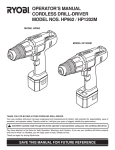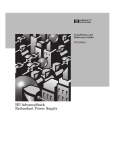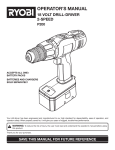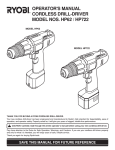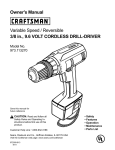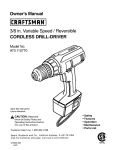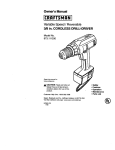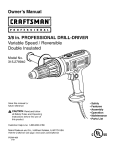Download Ryobi RC960 Operator`s manual
Transcript
OPERATOR'S MANUAL 9.6 VOLT AM/FM RADIO CHARGER Model No. RC960 STOR rgin g AGE 700 800 100 1000 104 2 98 00 14 1 0 8 AM 00 12 0 6 1 530 6 88 9 00 cha FM AM FM 1700 MHz TUNIN kHz G AM/F M ME SPECIFICATIONS: AM/FM Radio Charger Input Charging Voltage AM/FM Tuner Net Weight Model No. RC960 120 Volts, 60 Hz, AC Only 9.6 Volt AM: 520-1710 KHz FM: 87.9-107.9 MHz 2.2 Lbs. (1 kg.) THANK YOU FOR BUYING A RYOBI RADIO CHARGER. Your new radio charger has been engineered and manufactured to Ryobi’s high standard for dependability, ease of operation, and operator safety. Properly cared for, it will give you years of rugged, trouble-free performance. CAUTION: Carefully read through this entire operator’s manual before using your new radio charger. Pay close attention to the Rules for Safe Operation, Warnings, and Cautions. If you use your radio charger properly and only for what it is intended, you will enjoy years of safe, reliable service. Thank you again for buying Ryobi products. SAVE THIS MANUAL FOR FUTURE REFERENCE CAUTION: WARNING: RISK OF ELECTRIC SHOCK DO NOT OPEN To reduce the risk of fire or electric shock, do not expose this product to rain or moisture. WARNING: WARNING: To reduce the risk of electric shock, do not remove cover (or back). No user-serviceable parts inside. Refer servicing to qualified service personnel. To prevent electric shock, match wide blade of plug to wide slot, fully insert. IMPORTANT SAFETY INSTRUCTIONS FOR RADIO CHARGER AND SPECIFIC SAFETY RULES ■ Save these instructions. This manual contains important safety and operating instructions for charger. Following this rule will reduce the risk of electric shock, fire, or serious personal injury. ■ Before using charger, read all instructions and cautionary markings in this manual, on battery charger, and product using battery charger. Following this rule will reduce the risk of electric shock, fire, or serious personal injury. ■ To reduce risk of injury, charge only nickel-cadmium rechargeable batteries. Other types of batteries may burst causing personal injury and damage. Following this rule will reduce the risk of electric shock, fire, or serious personal injury. ■ Do not expose charger to wet or damp conditions. Following this rule will reduce the risk of electric shock, fire, or serious personal injury. ■ Use of an attachment not recommended or sold by the battery charger manufacturer may result in a risk of fire, electric shock, or injury to persons. Following this rule will reduce the risk of electric shock, fire, or serious personal injury. ■ ■ ■ To reduce risk of damage to charger body and cord, pull by charger plug rather than cord when disconnecting charger. Following this rule will reduce the risk of electric shock, fire, or serious personal injury. Make sure cord is located so that it will not be stepped on, tripped over, or otherwise subjected to damage or stress. Following this rule will reduce the risk of serious personal injury. An extension cord should not be used unless absolutely necessary. Use of improper extension cord could result in a risk of fire and electric shock. If extension cord must be used, make sure: a. That pins on plug of extension cord are the same number, size and shape as those of plug on charger. b. That extension cord is properly wired and in good electrical condition; and c. That wire size is large enough for AC ampere rating of charger as specified below: Cord Length (Feet) 25' 50' 100' Cord Size (AWG) 16 16 Note: AWG = American Wire Gage 16 ■ Do not operate charger with a damaged cord or plug. If damaged, have replaced immediately by a qualified serviceman. Following this rule will reduce the risk of electric shock, fire, or serious personal injury. ■ Do not operate charger if it has received a sharp blow, been dropped, or otherwise damaged in any way; take it to a qualified serviceman. Following this rule will reduce the risk of electric shock, fire, or serious personal injury. ■ Do not disassemble charger; take it to a qualified serviceman when service or repair is required. Incorrect reassembly may result in a risk of electric shock or fire. Following this rule will reduce the risk of electric shock, fire, or serious personal injury. ■ To reduce the risk of electric shock, unplug charger from outlet before attempting any maintenance or cleaning. Turning off controls will not reduce this risk. Following this rule will reduce the risk of electric shock, fire, or serious personal injury. ■ Disconnect charger from power supply when not in use. Following this rule will reduce the risk of electric shock, fire, or serious personal injury. ■ Risk of electric shock. Do not touch uninsulated portion of output connector or uninsulated battery terminal. ■ Do not place battery tools or their batteries near fire or heat. This will reduce the risk of explosion and possible injury. ■ For best results, your battery tool should be charged in a location where the temperature is more than 50°F (10°C) but less than 100°F (38°C). Do not store outside or in vehicles. ■ Never attempt to connect two chargers together. Page 2 IMPORTANT SAFETY INSTRUCTIONS FOR RADIO CHARGER AND SPECIFIC SAFETY RULES ■ The charger is designed to operate on standard household voltage. Do not attempt to use it on any other voltage. ■ Do not insert foreign matter into the battery port. ■ Do not charge by means of an engine generator or DC power source. ■ Do not disassemble the battery. ■ Do not charge or store the tool and battery in locations where the temperature may reach or exceed 100°F (38°C), such as outside sheds or metal buildings. ■ Do not incinerate the battery, even if it is severely damaged or completely worn out. The battery may explode in fire. ■ Do not short-circuit the battery. ■ A damaged battery is subject to explosion. To avoid serious personal injury, properly dispose of a damaged battery. ■ Do not discharge battery beyond normal use limits. Further discharging (such as by placing a rubber band on the trigger switch) can cause a deep discharge which may result in polarity reversal of a cell, rendering the battery useless. ■ Grounding or Polarization – This product may be equipped with a polarized alternating-current line plug (a plug having one blade wider than the other). This plug will fit into the power outlet only one way. This is a safety feature. If you are unable to insert the plug fully into the outlet, try reversing the plug. If the plug should still fail to fit, contact your electrician to replace your obsolete outlet. Do not defeat the safety purpose of the polarized plug. ■ Object and Liquid Entry – Never push objects of any kind into this product through openings as they may touch dangerous voltage points or short-out parts that could result in a fire or electric shock. Never spill liquid of any kind on the product. ■ Damage Requiring Service – Unplug this product from the wall outlet and refer servicing to qualified service personnel under the following conditions: Under extreme usage or temperature conditions, battery leakage may occur. If liquid comes in contact with your skin, wash immediately with soap and water, then neutralize with lemon juice or vinegar. If liquid gets in your eyes, flush them with clean water for at least 10 minutes, then seek immediate medical attention. ■ ■ ■ Batteries vent hydrogen gas and can explode in the presence of a source of ignition, such as a pilot light. To reduce the risk of serious personal injury, never use any cordless product in the presence of open flame. An exploded battery can propel debris and chemicals. If exposed, flush with water immediately. Ventilation – Slots and openings in the cabinet are provided for ventilation and to ensure reliable operation of the product and to protect it from overheating. These openings must not be blocked or covered. The openings should never be blocked by placing the product on a bed, sofa, rug, or other similar surface. This product should not be placed in a built-in installation such as a bookcase or rack unless proper ventilation is provided or the manufacturer's instructions have been adhered to. A) When the power-supply cord or plug is damaged, B) If liquid has been spilled, or objects have fallen into the product, C) If the product has been exposed to rain or water, D) If the product does not operate normally by following the operating instructions. Adjust only those controls that are covered by the operating instructions as an improper adjustment of other controls may result in damage and will often require extensive work by a qualified technician to restore the product to its normal operation, E) If the product has been dropped or damaged in any way, and F) When the product exhibits a distinct change in performance – this indicates a need for service. ■ Safety Check – Upon completion of any service or repairs to this product, ask the service technician to perform safety checks to determine that the product is in proper operating condition. ■ Wall or Ceiling Mounting – This product should be mounted to a wall or ceiling only as recommended by the Manufacturer. ■ Heat – The product should be situated away from heat sources such as radiators, heat registers, stoves, or other products (including amplifiers) that produce heat. ■ Save these instructions. Refer to them frequently and use them to instruct others who may use this tool. If you loan someone this tool, loan them these instructions also. Following this rule will reduce the risk of electric shock, fire, or serious personal injury. Page 3 IMPORTANT SAFETY INSTRUCTIONS ■ Heed Warnings – All warnings on the product and in the operating instructions should be adhered to. company. For products intended to operate from battery power, or other sources, refer to the operating instructions. ■ Follow Instructions – All operating and use instructions should be followed. ■ Power-Cord Protection – Power-supply cords should be routed so that they are not likely to be walked on or pinched by items placed upon or against them, paying particular attention to cords at plugs, convenience receptacles, and the point where they exit from the product. ■ Cleaning – Unplug this product from the wall outlet before cleaning. Do not use liquid cleaners or aerosol cleaners. Use a damp cloth for cleaning. ■ Attachments – Do not use attachments not recommended by the product manufacturer as they may cause hazards. ■ Accessories – Do not place this product on an unstable cart, stand, tripod, bracket, or table. This product may fall, causing serious injury to a child or adult, and serious damage to the product. Use only with a cart, stand, tripod, bracket, or table recommended by the manufacturer, or sold with the product. Any mounting of the product should follow the manufacturer's instructions, and should use a mounting accessory recommended by the manufacturer. ■ Power Sources – This product should be operated only from the type of power source indicated on the marking label. If you are not sure of the type of power supply to your home, consult your product dealer or local power ■ Lightning – For added protection for this product during a lightning storm, or when it is left unattended and unused for long periods of time, unplug it from the wall outlet and disconnect the antenna or cable system. This will prevent damage to the product due to lightning and power-line surges. ■ Overloading – Do not overload wall outlets, extension cords, or integral convenience receptacles as this can result in a risk of fire or electric shock. ■ Replacement Parts – When replacements parts are required, be sure the service technician has used replacement parts specified by the manufacturer or have the same characteristics as the original part. Unauthorized substitutions may result in fire, electric shock, or other hazards. SYMBOLS SAFETY AND INTERNATIONAL SYMBOLS This operator's manual describes safety and international symbols and pictographs that may appear on this product. Read the operator's manual for complete safety, assembly, operating and maintenance, and repair information. MEANING Do not expose to rain or use in damp locations. Page 4 SYMBOLS Important: Some of the following symbols may be used on your tool. Please study them and learn their meaning. Proper interpretation of these symbols will allow you to operate the tool better and safer. SYMBOL NAME DESIGNATION/EXPLANATION V Volts Voltage A Amperes Current Hz Hertz Frequency (cycles per second) min Minutes Time Alternating Current Type or a characteristic of current --- Direct Current Type or a characteristic of current n0 No Load Speed Rotational speed, at no load .../min Revolutions or Reciprocation Per Minute Revolutions, strokes, surface speed, orbits etc. per minute Safety Alert Symbol Indicates danger, warning or caution. It means attention!!! Your safety is involved. Lightning Alert Symbol The lightning flash with arrow head within a triangle is intended to tell the user that parts inside the product are a risk of electric shock to persons. The purpose of safety symbols is to attract your attention to possible dangers. The safety symbols, and the explanations with them, deserve your careful attention and understanding. The safety warnings do not by themselves eliminate any danger. The instructions or warnings they give are not substitutes for proper accident prevention measures. SYMBOL MEANING SAFETY ALERT SYMBOL: Indicates danger, warning, or caution. May be used in conjunction with other symbols or pictographs. DANGER: Failure to obey a safety warning will result in serious injury to yourself or to others. Always follow the safety precautions to reduce the risk of fire, electric shock and personal injury. WARNING: Failure to obey a safety warning can result in serious injury to yourself or to others. Always follow the safety precautions to reduce the risk of fire, electric shock and personal injury. CAUTION: Failure to obey a safety warning may result in property damage or personal injury to yourself or to others. Always follow the safety precautions to reduce the risk of fire, electric shock and personal injury. NOTE: Advises you of information or instructions vital to the operation or maintenance of the equipment. SAVE THESE INSTRUCTIONS Page 5 RULES FOR SAFE OPERATION READ ALL INSTRUCTIONS ■ READ THESE INSTRUCTIONS AND THE INSTRUCTIONS FOR YOUR HP962 DRILL-DRIVER THOROUGHLY before using this radio charger. ■ DO NOT CONNECT YOUR RADIO CHARGER TO POWER SUPPLY UNTIL YOU HAVE READ AND UNDERSTOOD ALL PRECAUTIONS AND OPERATING INSTRUCTIONS IN THIS MANUAL AND PRINTED ON RADIO CHARGER. ■ KNOW YOUR RADIO CHARGER. Read operator's manual carefully. Learn its applications and limitations as well as the specific potential hazards related to this radio charger. ■ CHARGE ONLY THE RECOMMENDED BATTERY PACK. Any attempt to use another battery pack will cause damage to your radio charger and could possibly explode, cause a fire, or personal injury. ■ DO NOT DISASSEMBLE YOUR RADIO CHARGER. ■ DO NOT PERMIT CHILDREN TO USE RADIO CHARGER. It is not a toy. ■ KEEP WORK AREA CLEAN. Cluttered areas and benches invite accidents. ■ AVOID DANGEROUS ENVIRONMENT. DO NOT use radio charger in a damp or wet environment or near a sink, tub, pool, or the like. ■ KEEP DRY, CLEAN, AND FREE FROM OIL AND GREASE. Always use a clean cloth when cleaning. Never use brake fluids, gasoline, petroleum-based products or any strong solvent to clean your radio charger. ■ STAY ALERT. Watch what you are doing and use common sense. Do not rush. ■ CHECK DAMAGED PARTS. Before further use of this radio charger, a part that is damaged should be carefully checked to determine that it will operate properly and perform its intended function. Do not use radio charger if it does not function properly. ■ ALWAYS DISCONNECT RADIO CHARGER FROM POWER SUPPLY WHEN NOT IN USE. ■ SAVE THESE INSTRUCTIONS. Refer to them frequently and use to instruct other users. If you loan someone this tool, loan them these instructions also. IMPORTANT INFORMATION Avoid mounting or storing your radio charger in these areas: ■ Areas exposed to direct sunlight or near appliances that generate heat. ■ Areas not well ventilated or dusty. ■ Areas subject to constant vibration. ■ Humid or moist areas. ■ High traffic areas. ■ Areas that children can reach. Look for this symbol to point out important safety precautions. It means attention!!! Your safety is involved. WARNING: The operation of any power tool can result in foreign objects being thrown into your eyes, which can result in severe eye damage. Before beginning power tool operation, always wear safety goggles or safety glasses with side shields and a full face shield when needed. We recommend Wide Vision Safety Mask for use over eyeglasses or standard safety glasses with side shields. Always wear eye protection which is marked to comply with ANSI Z87.1. Page 6 FEATURES KNOW YOUR RADIO CHARGER UNPACKING See Figure 1. Before attempting to use this product, familiarize yourself with all operating features and safety requirements. Features include easily operated am/fm radio; built-in charger; tool rest for your drill-driver and bit storage compartment. Your radio charger has been shipped completely assembled. Inspect it carefully to make sure no breakage or damage has occurred during shipping. If any parts are damaged or missing, contact your nearest Ryobi Authorized Service Center to obtain replacement parts before attempting to operate radio charger. LOCATION OF FEATURES AND CONTROLS WARNING: See Figure 1. If any parts are missing, do not operate this tool until the missing parts are replaced. Failure to do so could result in possible serious personal injury. FM ANTENNA CHARGE INDICATOR LIGHT (LED) STORAGE COMPARTMENT TOOL REST ADAPTER STOR char ging AGE AM/FM DIAL 700 800 100 1000 104 2 98 00 14 1 0 8 AM 00 12 0 6 1 530 6 88 9 00 POWER CORD FM AM FM 1700 MHz kHz TUNING SPEAKER AM/FM RADIO CHARGER AM/FM BATTERY PORT ME AM/FM BAND KNOB ON / OFF AND VOLUME CONTROL KNOB TUNING KNOB Fig. 1 RADIO CHARGER AND HP962 DRILL-DRIVER 20 See Figure 2. Figure 2 is a view of your radio charger with the HP962 Drill-Driver on the tool rest with one battery pack in charger and the other battery pack installed in drill-driver. v 9.6 15 AGE 700 800 100 AM 1000 104 6v 00 14 1 0 8 00 12 0 6 1 98 2 ging 530 6 88 9 00 STOR char FM AM FM 1700 MHz kHz TUNING AM/FM ME BATTERY PACK Fig. 2 Page 7 OPERATION ELECTRICAL CONNECTION CHARGING BATTERY PACK Your radio charger must be connected to a power supply that is 120 volts, 60 Hz, AC only (normal household current). Do not operate this radio charger on direct current (DC). A substantial voltage drop will cause a loss of power. If the radio charger does not operate when plugged into an outlet, check the radio charger, and then double check the power supply. See Figure 4. The battery pack for your drill-driver has been shipped in a low charge condition to prevent possible problems. Therefore, you should charge it overnight prior to use. Note: Batteries will not reach full charge the first time they are charged. Allow several cycles (drilling followed by recharging batteries) for them to fully charge. TO OPERATE RADIO TO CHARGE BATTERY PACK ■ Charge the battery pack for your drill-driver only with the radio charger provided. ■ Make sure power supply is normal household voltage, 120 volts, 60 Hz, AC only. ■ Connect adapter to power supply. ■ Place battery pack in charger. See Figure 4. Align raised rib on battery pack with groove in charger. ■ Push in on battery pack to be sure contacts on battery pack engage properly with contacts in charger. When properly connected, red light on charger will turn on and remain on until disconnected from power supply. ■ After normal usage, 3 hours or less of charging time is required to fully recharge battery pack. Note: If battery pack is completely discharged, 6 hours or longer of charging time is required to fully recharge battery pack. ■ The battery pack will become slightly warm to the touch while charging. This is normal and does not indicate a problem. ■ DO NOT place radio charger in an area of extreme heat or cold. It will work best at normal room temperature. ■ When battery pack has been charged, disconnect adapter from power supply and remove the battery pack. This practice will increase battery life. See Figure 3. ■ Connect adapter to power supply. Note: Radio does not operate on power from your drill's battery pack. ■ Set the AM/FM Band Knob to AM or FM position. ■ Turn radio ON by turning the ON/OFF Knob in a clockwise direction. Note: You will hear a soft click when radio comes ON. ■ Extend the antenna if radio is selected to listen to FM. If reception is poor, fully extend antenna and rotate in all directions until reception improves. ■ Adjust the volume up and down by turning the Volume Control Knob. ■ Set radio to the desired station by turning the Tuning Knob. ■ Turn radio OFF by turning the ON/OFF Knob in a counterclockwise direction. Note: You will hear a soft click when radio turns OFF. FM ANTENNA ADAPTER AM/FM DIAL STOR char ging AGE 700 800 100 1000 104 2 98 00 14 1 0 8 AM FM AM FM 1700 MHz char ging kHz TUNING POWER CORD CHARGE INDICATOR LIGHT (LED) 00 12 0 6 1 530 6 88 9 00 ADAPTER STOR AGE AM/FM 700 800 100 1000 104 2 98 00 14 10 8 FM AM FM MHz 1700 Fig. 3 1 ON/OFF AND VOLUME CONTROL KNOB AM 00 12 06 TUNING KNOB 530 6 88 9 00 ME SPEAKER AM/FM BAND KNOB kHz TUNIN G AM/FM ME Your radio charger is a AM/FM Radio with a built in charger for charging the battery pack supplied with your HP962 DrillDriver. Use this charger to charge only battery pack No. 1311146. Page 8 BATTERY PORT BATTERY PACK Fig. 4 OPERATION LED FUNCTION OF CHARGER WARNING: ■ LED on indicates battery pack is in charging mode. ■ LED does not come on indicates the following: a. No battery pack in the charger. b. Battery pack was not inserted into charger properly. Remove battery pack then reinsert. c. Battery pack is deeply discharged. Battery pack should remain in charger 5 to 30 minutes. The LED will come on automatically and start charging the battery pack; or d. Defective Battery Pack. Do not allow screws or other metal pieces to touch battery contacts or fall in battery port. Failure to do so can result in fire, explosion, or personal injury. STORA GE WARNING: To reduce risk of injury, charge only the recommended nickel-cadmium type rechargeable batteries. Other types of batteries may burst causing personal injury and damage. UPPER SIDE UPPER SIDE 6.00” 152.4 mm IMPORTANT INFORMATION FOR RECHARGING HOT BATTERIES BACK SIDE OF RADIO CHARGER Fig. 5 TAB STORAGE COMPARTMENT TO CLOSE S ROT EGA When using your drill-driver continuously, the batteries in your battery pack become hot. You should let a hot battery pack cool down for approximately 30 minutes before attempting to recharge. Note: This situation occurs when continuous use of your drill-driver causes the batteries to become hot. It does not occur under normal circumstances. Refer to "Charging Battery Pack" for normal recharging of batteries. If the charger does not charge your battery pack under normal circumstances, return both the battery pack and radio charger to your nearest Ryobi Authorized Service Center for electrical check. DOOR TO OPEN char ging 700 800 100 1000 104 2 98 00 14 1 0 8 AM 00 12 0 6 1 See Figure 5. Your radio charger has a "key hole" hanging feature for convenient, space saving storage. Screws should be installed so that center distances are 6 in. (152.4 mm) apart. 530 6 88 9 00 MOUNTING RADIO CHARGER FM AM FM 1700 MHz kHz TUNING CAUTION: AM/FM ME Mount radio charger to a surface that will accommodate the weight of the radio charger, drill, and both batteries. STORAGE COMPARTMENT See Figure 6. A storage compartment is located on the top portion of your radio charger. This storage compartment is convenient for storing small items such as bits, screws, washers, etc. The door to the compartment opens and closes in the direction of the arrows as shown in Figure 6. Pull back on tab and lift up on door to open. When closing door, make sure tab snaps into place so items will not fall out. Page 9 Fig. 6 MAINTENANCE DO NOT abuse power tools. Abusive practices can damage tool as well as workpiece. WARNING: When servicing, use only identical replacement parts. Use of any other part may create a hazard or cause product damage. WARNING: Do not at any time let brake fluids, gasoline, petroleumbased products, penetrating oils, etc. come in contact with plastic parts. They contain chemicals that can damage, weaken or destroy plastic. WARNING: Do not attempt to modify this product or create accessories not recommended for use with this product. Any such alteration or modification is misuse and could result in a hazardous condition leading to possible serious personal injury. NOTES Page 10 NOTES Page 11 OPERATOR'S MANUAL 9.6 VOLT AM/FM RADIO CHARGER Model No. RC960 • SERVICE Now that you have purchased your Radio Charger, should a need ever exist for repair parts or service, simply contact your nearest Ryobi Authorized Service Center. Be sure to provide all pertinent facts when you call or visit. Please call 1-800-525-2579 for your nearest Ryobi Authorized Service Center. You can also check our web site at www.ryobitools.com for a complete list of Authorized Service Centers. • MODEL NO. AND SERIAL NO. The model number and serial number of this radio charger will be found on a plate attached to the back of the unit. Please record the serial number in the space provided below. • NAME OF ITEM Radio Charger • MODEL NUMBER RC960 • SERIAL NUMBER Ryobi Technologies Inc. 1428 Pearman Dairy Road Anderson, SC 29622 Post Office Box 1207 Anderson, SC 29622-1207 Phone 1-800-525-2579 www.ryobitools.com 983000-009 4-02













